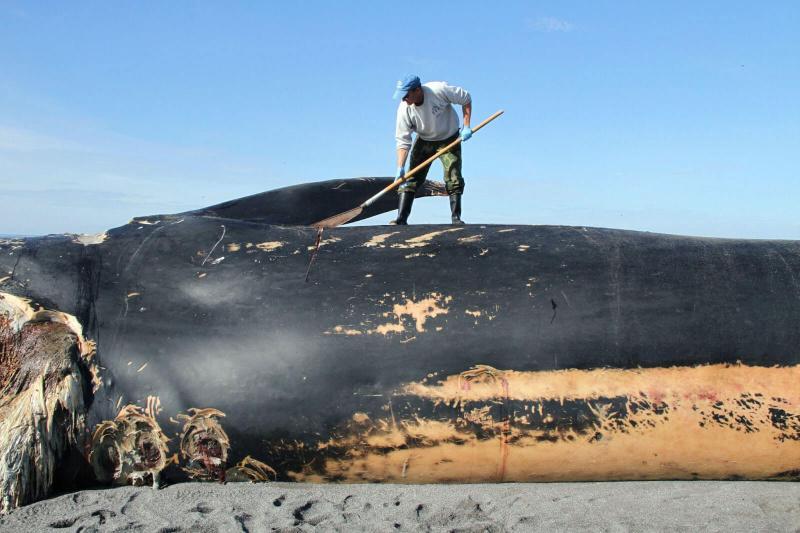
Oregon Marine Mammal Network responds to stranded marine mammals
by NOAA Fisheries 15 Apr 2023 15:54 UTC

Jim Rice begins a necropsy on a blue whale (Balaenoptera musculus) at Gold Beach, Oregon in 2015 © Jared Hughey
The Oregon Marine Mammal Stranding Network responds to more than 400 marine mammal strandings along the Oregon coast each year.
In most stranding cases, the cause of the stranding is unknown, but some identified causes have included disease, parasite infestation, harmful algal blooms, injuries from ship strikes or fishery entanglements, pollution exposure, and starvation. To help with these strandings, the Network leverages the assistance of universities, state and federal agencies, and citizen volunteers to respond to incidents along the Oregon coastline.
The Oregon Stranding Network's objectives are to:
- Advance public education about marine mammal strandings
- Document and investigate Oregon marine mammal stranding events
- Provide continuous surveillance for emerging, infectious, and zoonotic diseases
- Promote the welfare of live stranded animals by mitigating harassment, disentangling marine mammals from debris and fishery gear, and providing euthanasia to severely injured animals
Meet Stranding Manager Jim Rice
Stranding manager Jim Rice found his passion for working with marine mammals while he was in college. His studies led him to a career as a marine mammal trainer, and later as a stranding response biologist. "This line of work offers me a unique view of the natural world, and a close-up look at the changes happening in the marine environment," says Rice.
Some of the most interesting calls often involve species that are challenging to identify due to the rarity of their strandings, shares Rice. In 2015, a deceased Stejneger's beaked whale stranded at a local beach. Not knowing enough about the animal to conduct a necropsy, Rice consulted with several beaked whale experts before proceeding.
Some inquiries from the public are not even about marine life. Rice says that occasionally there are calls describing "miscellaneous terrestrial species that occasionally wash ashore, such as deer, cows, and bears."
Historic Sea Lion Cave Disentanglement
On March 18, 2010, Rice received a call about an entangled Steller sea lion inside Sea Lion Caves, a popular tourist attraction north of Florence, Oregon. The sea lion was pinned to a rock without access to food or water. After receiving special permission to enter the caves, Rice and the response team successfully disentangled the sea lion from the net. Their actions prevented serious injury, infection, and further starvation.
Disentangling a sea lion is a serious endeavor, involving risks to the animal and to the rescuers. Steller sea lions can be dangerous animals that often react aggressively when humans get close to them. Anticipating this defensive behavior, the team brought a veterinarian, who lightly sedated the animal before they removed the net.
"There was a fair amount of net wrapped around its face and neck, and several feet of trailing net was trapped between the rocks. The animal only had about a 10-foot radius of movement," said Jim Rice. "Once the netting was released, the tissue in the neck bounced back and regained its normal appearance almost immediately."
How to help wildlife responsibly
First, determine if the animal is truly stranded. A whale, dolphin, or porpoise on the beach should be called in immediately. But many seals and sea lions that haul out and rest on land are not in distress. You can evaluate the animal's behavior from a distance, and monitor their condition for 24 hours. Let others who are nearby know to stay at least 100 yards away (about the length of a football field). Keep pets 100 yards away, help minimize disturbances if possible, and be aware of hazards or rising tides and monitor from an area that is safe. To report a dead, injured, or stranded marine mammal along the West Coast, please contact the West Coast Region Stranding Hotline at (866) 767-6114.